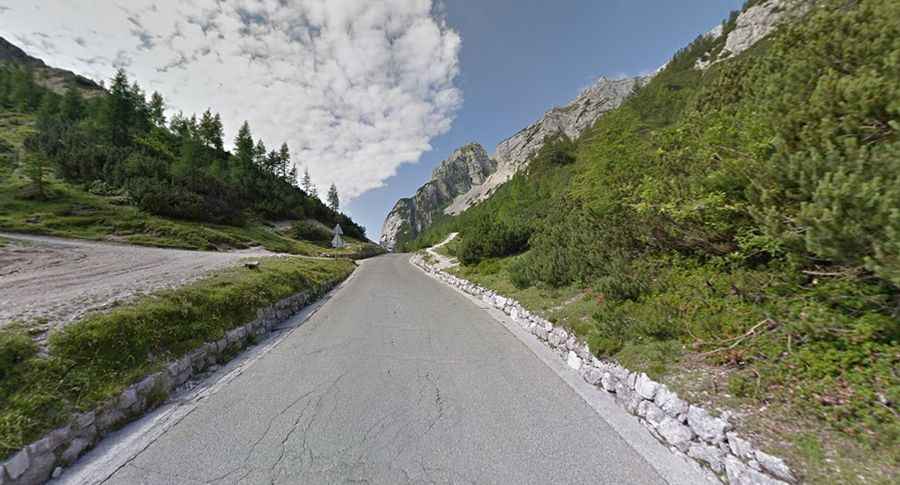Driving the spectacular Russian Road to Vrsic Pass in the Julian Alps
Vršič Pass is a high mountain pass at an elevation of 1,632m (5,354ft) above sea level, located in Slovenia. The road through the pass was built by prisoners in 1915, and it is one of the highest roads in the country.

Where is Vršič Pass?
The pass is located on the boundary between Upper Carniola and Gorizia regions, on the northwestern part of the country. It links Upper Carniola with the Trenta Valley in the Slovene Littoral.
How long is Vršič Pass?
The pass is 43.4 km (26.96 miles) long, running from Bovec to Trenta. The road is entirely paved, with some cobblestone sections. It’s called 206 Road, known as Ruska cesta ("Russian Road"), renamed in July 2006 to honor the Russian prisoners of war who were forced to build it. The road is an exhilarating and spectacular drive, climbing and descending 50 hairpin bends, each one numbered and with height recorded, taking you across the spine of the Julian Alps.
Is Vršič Pass safe to drive?
Surrounded by the peaks of the Julian Alps near the mountains and glacial lakes of Triglav National Park, the road is plenty wide enough to pass and in remarkably good condition. It is well maintained. If you are an experienced driver with decent situational awareness, it's very doable, so don't miss out on the experience. The drive features 50 hairpin bends, 24 on the Kraniska Gora side and 26 on the Trenta side of the pass. At the beginning of the road, starting on the Italian side, there’s a blue plaque with the number 50 and information about the altitude. There are the same blue signals, marking the sharpest, steepest, and most challenging corners on the route. Each turn is numbered. This trip doesn’t allow any moment of distraction, and there’s no room for overtaking. It is not a difficult route, though not recommended if you are towing a caravan. Despite the very well-maintained roads, Vršič Pass is inevitably a bit of a hair-raising drive.
Is Vršič Pass steep?
Starting from Trenta, the ascent is 11.82 km long. Over this distance, the elevation gain is 993 meters. The average percentage is 8.4%.
What to see on Vršič Pass?
Plan 1.5 hours to complete the drive without any stop. If you like scenic drives and want to see a beautiful part of the country, this Slovenian road trip is a wonderful day trip idea. The road doesn’t have much traffic because people who want to travel to Kranjska Gora prefer to use the Austrian way, on a wider toll road. Expect high traffic in high season. There are several parking spots to stop and admire the stunning mountain views.
Is Vršič Pass open?
The road is open an average of seven months per year. Winter comes early at high elevations and lingers late. In winter, it is usually closed to all traffic. Extreme weather is common. The upper elevations of the road are rendered impassable by heavy snowfall during much of winter.
When was the road to Vršič Pass built?
The road over Vršič was built by Russian prisoners in 1915. The Austro-Hungarian authorities decided early in 1915 that they needed a road to supply their forces who were preparing to defend their border with Italy (to become known as the Isonzo Front). Building, using Russian prisoners-of-war as forced labor, began in March 1915 and, unbelievably, was completed by the end of that year. The pass needed to be kept open all year, so prisoners were stationed in camps to shovel the snow off the road during the winter months. In March 1916, an avalanche buried one of these camps, killing around 400 prisoners and 10 of their guards. There is a small Russian cemetery near hairpin 4. To commemorate this disaster and in remembrance of their comrades, other Russian prisoners built a beautiful Russian Orthodox Chapel on the site of the camp, and this can be seen by stopping at hairpin 8. To honor the Russian prisoners, the road was renamed in July 2006 as the Ruska cesta (“Russian Road”). Up there, you will also find the remnants of WWI bunkers and a telpher cable-car line. The Slovene common noun vršič literally means 'little peak', a diminutive form of the word vrh 'peak'.